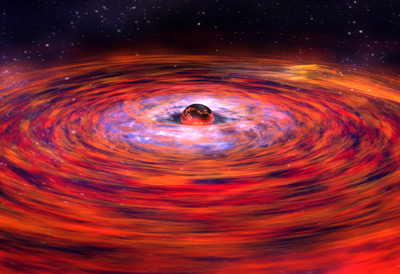This article is more than 1 year old
Boffins bend space and time to measure neutron star
Einstein shouts 'told you so', through tear in space-time
Astronomers have caught three neutron stars in the act of distorting space-time, just as Einstein predicted. Bendy space-time has been seen around black holes before, but this is the first time astronomers have seen it around any other body.
Sudip Bhattacharyya and Tod Strohmayer, both of NASA’s Goddard Space Flight Center, turned the XMM-Newton observatory to a binary system called Serpens-1, whose neutron star has a disc of hot iron atoms whirling around just above its surface at around 40 per cent of the speed of light.

The NASA team studied the line these atoms produce in the emission spectrum it produces, and discovered that the line is not clean, but smudged asymmetrically by a combination of its relativistic velocity and the effect of the neutron star's powerful gravitational field.
"We have seen these asymmetric lines from many black holes, but this is the first confirmation that neutron stars can produce them as well. It shows that the way neutron stars accrete matter is not very different from that of black holes, and gives us a new tool to probe Einstein’s theory," says Strohmayer.
A neutron star has such a strong gravitational field because, as the name suggests, it is formed entirely of neutrons. One is formed when a star of more than 8 times the sun's mass exhausts its supply of hydrogen and helium, and starts to burn heavier and heavier atoms, until all that is left is its iron core.
When it runs out of fuel, the weight of the star is such that it collapses inwards, fusing the protons and electrons in the iron to form neutrons. The star has now effectively become a truly gigantic atomic nucleus. It holds roughly one and a half times the matter as our own sun, but crammed into a sphere of just a 20 - 30km radius. It is so dense, a cupful would weigh the same as Mount Everest.
The pair of scientists has already confirmed their work with another research group. Working in a group led by Edward Cackett and Jon Miller of the University of Michigan, they used Suzaku’s superb spectral capabilities to survey three neutron-star binaries: Serpens X-1, GX 349+2, and 4U 1820-30.
The Suzaku data revealed a nearly identical iron line in Serpens-1, and similarly skewed lines in the other two binaries.
This team observed a nearly identical iron line in Serpens X-1, confirming the XMM-Newton result. It detected similarly skewed iron lines in the other two systems as well.
Cackett explains that the work has given researchers another tool to deploy in their study of the stars.
"We’re seeing the gas whipping around just outside the neutron star’s surface. And since the inner part of the disc obviously cannot orbit any closer than the neutron star’s surface, these measurements give us a maximum size of the neutron star’s diameter," he says.
"The neutron stars can be no larger than 29 to 33 km across, results that agree with other types of measurements." ®
